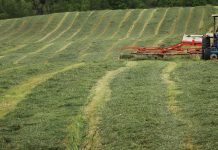After a brief warm-up the first few days of March, we had our biggest snowfall of the winter — 14 inches on March 5.
The following morning the thermometer plunged two degrees below zero. The next day, winter loosened its grip. Temps crept into the 40s, and the snow began to melt. Fortunately the ground was not frozen; it had been protected from the sub zero temperatures by the heavy snow.
On Monday evening, after a high temperature of 45 degrees and under a clear sky and a nearly full moon, I stepped onto the back porch for some fresh air and listened in hopeful anticipation.
Familiar spring sounds
After just a few minutes, I heard a familiar, high-pitched twittering sound. It was descending into the old field just below the house. Moments after the twittering ended, I heard the distinctive, “Peent!” At least one male American woodcock was back, probably probing for earthworms in the soft soil between aerial displays.
Woodcock are a favorite and reliable harbinger of spring. The distinctive nasal peenting gives them away. After the first peent, more are sure to come. About two minutes later another peent sounds. Soon the weird calls come faster and faster, and the interval between calls can be measured in seconds.
Hard to find
Woodcock are plump, bobwhite-sized birds that weigh six or seven ounces. Taxonomically classified as shorebirds, they live in the woods, but at dusk they move to open areas to perform courtship displays.
Woodcock have huge eyes positioned high and far back on their skulls, so they actually can see above and behind their heads. They use their long, flesh-colored bill to probe moist, soft soil for earthworms and other invertebrates. Since woodcock spend so much time with their bills in the ground, their near 360-degree field of vision helps them detect aerial predators overhead.
Woodcock also enjoy the protection of cryptic coloration or camouflage. Dappled in shades of brown, woodcock are almost impossible to see as they rest among leaves on the forest floor. They will not flush until almost stepped upon. They are among nature’s most perfectly camouflaged birds.
A hen incubating a clutch of four eggs is particularly difficult to spot among the leaf litter. When the eggs hatch after 21 days of incubation, the precocial chicks are equally difficult to find. When alarmed by an intruder, the chicks hunker down beneath the wings of the protective hen.
Bold display
Displaying male woodcock are not nearly so shy. At dusk, they move from the protective cover of the woods to open fields and actually advertise their presence. They want to be seen — by females.
To watch the show, birders must get into position just before dark and wait. After the first peent, males call repeatedly. When the calls stop abruptly, the male jumps into the sky. He ascends in an ever-widening spiral flight to a height of 250 to 300 feet. At that point he hovers momentarily, then descends in zigzag fashion, almost like a falling leaf.
Air rushing through the three stiff outer wing feathers makes whistling sounds that are accompanied by a liquid, vocal twitter. If there are females nearby, they notice. Upon landing, the male fans his tail and wings and struts about boldly in hopes that at least one hen will find his display irresistible. While strutting about, a male woodcock resembles a chunky miniature ruffed grouse or turkey gobbler. If one or several females succumb to the performance, mating follows.
Woodcock displays can last for hours between dusk and dawn from early-March through early May. Clear, moonlit nights provide the best chance for catching a glimpse of silhouetted woodcock displays. But remember, much of the performance is vocal.
Yearly tradition
The dance of the woodcock is a rite of spring that every birder should experience at least once. It requires no special equipment, just a few hours of spare time. Nature centers and bird clubs often sponsor field trips to woodcock dancing grounds. Watch for just such an opportunity, and sign up for an adventure you’ll talk about for years.












